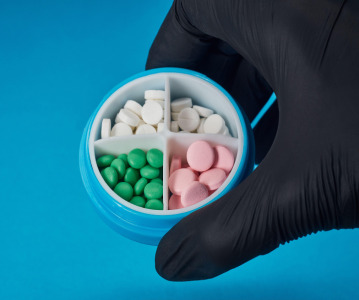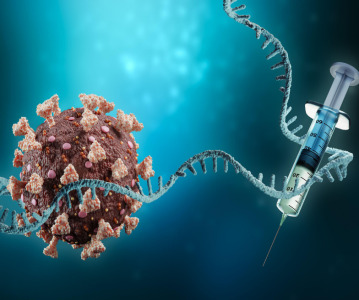Spray Drying: A Proven Approach to Enhance the Solubility of Active Pharmaceutical Ingredients

Spray drying is an established particle engineering technology that offers several advantages over other methods used for improving API bioavailability
Author: Benzion Dolitzky, PhD, VP R&D at Wavelength Pharmaceuticals
Low aqueous solubility of active pharmaceutical ingredients (APIs) often translates to poor bioavailability that can be a cause of failure during drug development. For this reason, improved aqueous solubility is a primary objective of formulation development. Spray drying is an established particle engineering technology that has been widely used to enhance the solubility of oral, inhaled, and topical drugs. It involves producing dry powders from a fluid material by atomization into a hot drying gas medium, usually air or nitrogen. A main advantage of spray drying is its capacity for continuous operation that enables the implementation of process analytical technology to safeguard highly reproducible drug production. Spray drying is also faster, more cost-effective, and easier to manage than many other particle engineering technologies, and is readily scalable, especially in the hands of an experienced API CDMO. Notably, with the number of poorly soluble small molecule drugs continuing to grow, the demand for spray drying capacity is on the rise and production slots are booked well in advance. While next generation spray drying technologies promise to help alleviate the bottleneck, Wavelength Pharmaceuticals continues to invest in both current and novel spray drying methodologies, to deliver on these strategic market needs. With spray drying expertise gained from more than 30 years of developing and manufacturing its own product portfolio Wavelength has invested in state-of-the-art equipment to support a wide range of manufacturing requirements, from small-scale clinical drug development projects through commercial-scale GMP production.
Low aqueous solubility is a major problem
Oral dosing represents the most convenient form of drug delivery and is commonly associated with high patient compliance. However, low aqueous solubility can be a major problem when developing oral dosage forms since it restricts drug absorption within the gastrointestinal tract to limit bioavailability. Low aqueous solubility can also present problems when developing inhaled drugs, or products that will be applied as topical, transdermal, or ophthalmic treatments. Addressing low aqueous solubility is therefore a primary objective of formulation development to help assure regulatory approval and bring urgently-needed therapeutics to patients. To rationalize formulation development, the Biopharmaceutics Classification System (BCS) categorizes drug substances according to aqueous solubility and permeability – the two main factors influencing drug absorption. Based on the BCS criteria, Class 1 drugs are characterized by high solubility and high permeability, Class 2 drugs by low solubility and high permeability, Class 3 drugs by high solubility and low permeability, and Class 4 drugs by low solubility and low permeability. Both Class 2 and Class 4 drugs are candidates for solubility enhancement.
Figure 1. The Biopharmaceutics Classification System (BCS) as defined by the FDA after Amidon et al.
Formulation development addresses aqueous solubility
Formulation development involves determining which excipients will be combined with the API in the final product to provide the delivery dosage form, whether that be solid, liquid, or semi-solid (e.g. a hydrogel). Critically, formulation development is where API aqueous solubility issues are best addressed, typically through designing different API salts, developing co-crystals, or through particle engineering.
Although designing different API salts is a familiar approach, it is largely based on trial and error as the link between salt form and solubility is currently poorly understood. Moreover, because some APIs lack the functional groups required for salt formation, comparing different salts is not always a viable strategy. Co-crystallization overcomes this problem by combining the API and one or more co-formers in the same crystal lattice. It provides opportunities for developing solid-state forms other than conventional salts and polymorphs, and is also open to supramolecular engineering – the exploitation of supramolecular interactions such as Van der Waals forces, hydrogen bonding, and electrostatic interactions to improve the physicochemical properties of the API.
Particle engineering technologies include micronization, lyophilization, and spray drying. Micronization functions to reduce the average particle diameter of a solid material through collisions with moving parts of the milling system (e.g., ball-milling, pin-milling, or hammer milling) or with itself (e.g., jet milling). A main drawback of this method is that the mechanical stresses it generates can cause local heating that may lead to melting, degradation, or structural defects; micronization also offers only limited control over key particle characteristics and has high associated material losses. Lyophilization and spray drying are more controllable and instead involve rapid drying of a liquid containing the dissolved API to generate an amorphous solid dispersion (ASD). Spray drying provides several important advantages over lyophilization, including elimination of the need for a post-drying milling step, as discussed below.
Spray drying is an established solubility enhancement technology
Spray drying has been successfully applied across multiple industries (predominantly the food and pharmaceutical industries) to convert a liquid feed into a powder. In drug manufacturing, it is an established particle engineering technology that involves dissolving the API in a solvent with one or more polymers (to prevent crystallization) and any necessary excipients, before injecting the mixture into a specialized spray dryer apparatus. As the liquid enters the spray dryer, it is atomized by a nozzle to form small, spherical droplets; these are then rapidly dried by a powerful blast of heated air (or nitrogen when working with organic solvents) within the spray drying chamber. Following any additional drying cycles, and particle separation in a cyclone, the resulting ASD is collected and can be used to manufacture the final drug product. The main objective of the spray drying process is to transform the API into an ASD exhibiting improved solubility and physical stability compared to the parent material.
Figure 2. The spray drying process.
Advantages of spray drying
A major advantage of spray drying over other particle engineering technologies is its capacity to operate as a rapid, continuous process. This removes any limitations on batch size, as well as allowing for the implementation of process analytical technology to ensure reliable operation. Moreover, unlike technologies such as micronization and lyophilization, spray drying avoids the need for a milling step (during lyophilization, milling is occasionally required to convert the dried material into a fine powder) that can compromise the performance of thermolabile APIs or biologics that are sensitive to abrasion or shearing. Perhaps most importantly, spray drying provides tight control over critical product parameters such as particle size, density, and morphology; these can be fine-tuned by adjusting key process parameters or changing the sprayed solution composition to ensure consistent production of a high-quality product. Additionally, when compared directly with lyophilization, spray drying is more cost-effective and compatible with a broader range of solvents; these include both water-based solutions and class 3 solvents such as methanol, ethanol, acetone, and ethyl acetate, which can be recovered and recycled.
Challenges of spray drying
Despite being a leading technology to enhance drug solubility, spray drying requires an experienced operator to accurately control particle quality and yield. Factors that must be considered include the composition, concentration, and stability of the parent solution (both the drug and any polymers need to dissolve in the solvent system) and whether heating is required to decrease the viscosity of the feed; in this scenario, both the API and any excipients must be stable at high temperature. It is also important to select an appropriate nozzle; while pressure nozzle atomization may be more suitable where a larger average particle size is required, rotary nozzle atomization is often preferred for achieving a narrower particle size distribution (PSD), and multi-feed nozzles should be used where two or more liquids will be injected in parallel. Other considerations include whether the air / nitrogen should be blown from the bottom of the drying chamber or the top (the latter is frequently employed as a means of preventing over-heating), and the temperature at both the inlet and the outlet points, which is critical for producing stable particles and ensuring process robustness. The size of the spray dryer will be dictated by the required production scale; models range from benchtop size for initial development stages through larger commercial scale spray dryers capable of producing kilograms of material per hour.
Leverage the benefits of spray drying through partnership with an experienced API CDMO
The effective use of spray drying for solving solubility and bioavailability challenges in drug manufacturing hinges on strong expertise in process design and development, as well as a robust working knowledge of all quality and regulatory requirements for GMP commercial production. Experience is also critical to establish early on whether a particular drug substance is an appropriate candidate for spray drying (or more suitable for other bioavailability enhancing technologies), and to efficiently identify formulation conditions that provide the desired solubility, dissolution rate, content uniformity, and bioavailability. One way of accessing this knowhow is to partner with an API CDMO experienced in the use of spray drying for a broad range of drugs – including high potency APIs (HPAPIs) - and offering the right equipment, team, and facilities for the job.

Related News
-
News Pharmapack Awards 2024 Patient-Centric Design Award Winner – Dr Ferrer BioPharma
The 2024 Pharmapack Awards celebrated the best in innovation and design for the pharmaceutical packaging and drug delivery industry on January 24, 2024. -
News Pharmapack Awards 2024 - Celebrating Packaging and Drug Delivery Innovation
The 2024 Pharmapack Innovation Awards ceremony celebrated the best in pharmaceutical packaging and drug delivery innovation at all levels. The awards were held on January 24, 2024 at the Paris Expo Porte de Versailles. -
News Women in Pharma: Looking back on 2023 and moving forward to 2024
In this monthly series, we interview women from across the pharmaceutical industry and supply chain to discuss the importance of gender diversity in healthcare, the workplace, and beyond. -
News On track at CPHI Barcelona - The Track Sponsor interview: USP
In our packed out content sessions at CPHI Barcelona this year we focus on some of the hottest topics coming up in the pharma industry, with each track sponsored by a leading expert in the field. -
News Women in Pharma: Marketing for the other half in healthcare
In our new monthly series, we interview women from across the pharmaceutical industry and supply chain to discuss the importance of gender diversity in healthcare, the workplace, and beyond. This instalment highlights not only the importance of ma... -
News Bringing the pharmaceutical supply chain closer to home
The pharmaceutical supply chain has encountered numerous disruptions in the last few years, impacting procurement, manufacturing, packaging, and distribution operations within the pharmaceutical industry. Read about the rise in calls for near/resh... -
News Delivering on mRNA-based therapeutics: innovations in applications and packaging
Since the onset of the COVID-19 pandemic, the innovative potential of mRNA vaccines and therapeutics has raised questions regarding their manufacturing, packaging, and storage/transportation. Learn about how the pharmaceutical supply chain is meet... -
News Your Prescription for Marketing Success: Digital Pharma Marketing Toolkit – Free eBook
Download your FREE pharma marketing eBook to learn why it is so important for pharmaceutical marketeers to develop their digital content marketing strategies in order to establish their companies as thought leaders and industry experts.
Position your company at the heart of the global Pharma industry with a CPHI Online membership
-
Your products and solutions visible to thousands of visitors within the largest Pharma marketplace
-
Generate high-quality, engaged leads for your business, all year round
-
Promote your business as the industry’s thought-leader by hosting your reports, brochures and videos within your profile
-
Your company’s profile boosted at all participating CPHI events
-
An easy-to-use platform with a detailed dashboard showing your leads and performance







